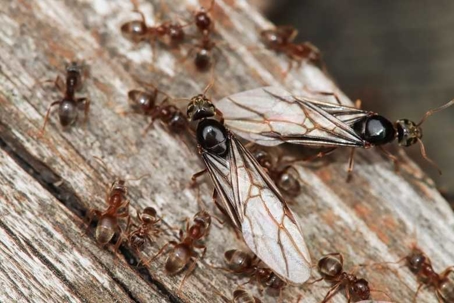What Can Field Ants Eat?
Field ants are generalist foragers, meaning they can consume a wide variety of foods. The diet of these ants typically depends on the exact species, season, and available resources, but generally includes:
Sugars and Carbohydrates: Nectar from flowers. Honeydew produced by aphids, scale insects, and other sap-sucking insects. Fruit juices and rotting fruit. Sugary human foods like syrup, candy, or soft drinks (if accessible).
Proteins: Insects, dead or alive (other small arthropods). Carrion (dead animals). Seeds and certain grains. Fungal material (some species cultivate or consume fungi).
Lipids and Fats: Insects with high-fat content. Seeds and nuts that contain oils
Miscellaneous: Some field ants may consume plant sap, pollen, or small pieces of leaves. Soil organic matter (in minimal amounts, sometimes for nutrition or fungus cultivation)
Field ants usually send out workers to scout and transport food back to the colony. They often prefer food sources high in sugar or protein depending on the colony’s current needs (e.g., sugar for energy, protein for brood development).
What Do Field Ants Eat?
Field ants generally prefer sugary foods, especially those high in carbohydrates, because these provide quick energy for foraging and colony activities. This includes:
Honeydew from aphids or other sap-sucking insects (a primary natural sugar source)
Nectar from flowers
Ripe or rotting fruit
Other sugary plant exudates
However, their preferences can shift depending on the colony’s needs:
Protein sources (insects, small arthropods, or meat) are sought primarily to feed developing larvae.
Fats and oils are occasionally collected, especially if the colony is in need of high-energy reserves.
In practice, sugar is usually most attractive to workers for immediate energy, while protein is targeted more selectively for brood development.
Do Field Ants Eat Insects?
Field ants are opportunistic predators and scavengers when it comes to insects. They generally consume:
Small live insects – They will hunt or overwhelm insects smaller than themselves, such as aphids (sometimes more for honeydew than as prey), thrips, small caterpillars or larvae, springtails and other tiny arthropods.
Dead or injured insects (carrion) – They are efficient scavengers, feeding on dead flies, beetles, or grasshoppers, and insect carcasses from other predators or environmental causes.
Soft-bodied insects are easier to subdue and digest. These include larvae of other insects, and pupae or eggs of insects in soil or leaf litter.
Insects providing protein for larvae – Some field ant species specifically forage for insects rich in protein to feed the brood, even if the workers themselves mainly consume sugar.
Their hunting and scavenging behavior can vary by species and colony needs, but generally, anything small, vulnerable, or dead is fair game.
Do Field Ants Eat Animals?
Yes, field ants can and do consume animals, but usually in small or scavenged forms, rather than hunting large live prey. Their animal-based diet primarily includes:
Small invertebrates – Most common, including insects (live or dead), spiders, and other arthropods like mites or small crustaceans.
Carrion – Field ants are opportunistic scavengers, feeding on dead insects, small mammals, or birds (if accessible), and small amphibians or reptiles in some cases.
Animal-derived fluids – Rarely, field ants may feed on blood from injured animals (if exposed and reachable), as well as fatty tissues from carcasses.
Field ants are generally not large enough to kill substantial animals themselves. They rely on scavenging dead or weak animals or preying on small invertebrates. Their animal consumption is mostly for protein and fat, especially to feed larvae, while adult workers often favor sugars for energy.
Do Field Ants Eat Plants?
Field ants don’t typically “eat” plants in the traditional sense—they are not herbivores—but they do consume plant-derived substances and interact with plants in several ways:
Sugary plant exudates
Nectar from flowers is a major food source.
Honeydew from aphids, scale insects, or other sap-sucking insects feeding on plants (ants often “farm” these insects for this sugary secretion).
Sap from broken stems, leaves, or wounded trees.
Fruits and seeds
Ripe or overripe fruit: ants feed on juices and soft tissues.
Seeds: some ants are granivorous, carrying seeds to their nests to eat the nutritious parts. Some even disperse seeds (myrmecochory).
Fungi and microbial growth on plants
Some species cultivate or feed on fungi growing on decaying plant material.
Leaf and plant tissue (limited)
Most field ants do not chew live leaves extensively, but a few species may collect small amounts of plant tissue, primarily to cultivate fungi (like leafcutter ants).
Field ants mainly target sugars from nectar or honeydew, and sometimes fruit or seeds, while consuming little actual leaf or stem tissue. Their “plant diet” is usually indirect—through sugary secretions or soft plant parts.

